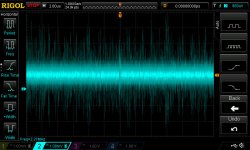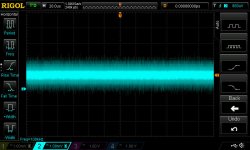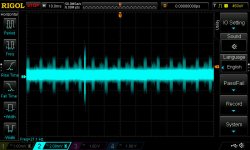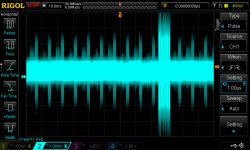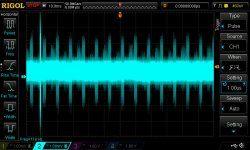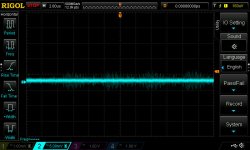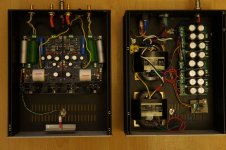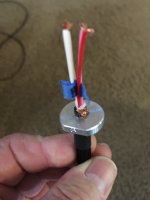I have had an interesting experience with my SALAS phono amp.
The last month I have been using digital only, I got an SDTrans which is the best digital player I have ever heard. Getting it settled in and, of course, making PS changes.
During this time I had left the SALAS unpowered.
Before I switched over I had been annoyed at a few noises I could not seem to quiet. I am used to noise with analog, it is not as if they were a problem but they were there.
Switching back to analogue yesterday when I first turned up the volume control I thought, "what have I done, there is no noise". That sinking feeling the DIYer knows all too well. Yet, when I brushed my stylus it was clear there was nothing wrong. Nothing wrong at all. The system was silent.
When returning to analog one prepares themselves for the inevitable noises and yet, after this one month's rest the phono stage is much quieter than it was before.
I had left the phono stage on all of the time and now I wonder if this is not a good idea? Could I have set off some oscillation that continued until I turned the thing off? Is there a form of "latch-up" possible with this circuit? The thing sounded fine before and sounds fine now, the only difference was the lack of a hum though of a higher frequency than my line voltage and some other artifacts higher up in frequency.
Thought this was interesting. Now I know if the noises return how to get rid of them. Still would prefer to leave the amp on all of the time.
One last thing, as good as the SDTrans is, and it does bring me closer to good sound than the computer setup I was using, digital still does not have that hard to describe RIGHTNESS of analog. I do not think it ever will though it does have many good qualities and one can enjoy it, it just lacks immediacy and wholeness.
As Harry Pearson said, and I am not a big fan but this comment stands as one of his most memorable: if you want to enjoy digital audio DO NOT listen to analog. This is true, if you are not exposed to good analog audio you could be forgiven for thinking digital is "perfect".
The last month I have been using digital only, I got an SDTrans which is the best digital player I have ever heard. Getting it settled in and, of course, making PS changes.
During this time I had left the SALAS unpowered.
Before I switched over I had been annoyed at a few noises I could not seem to quiet. I am used to noise with analog, it is not as if they were a problem but they were there.
Switching back to analogue yesterday when I first turned up the volume control I thought, "what have I done, there is no noise". That sinking feeling the DIYer knows all too well. Yet, when I brushed my stylus it was clear there was nothing wrong. Nothing wrong at all. The system was silent.
When returning to analog one prepares themselves for the inevitable noises and yet, after this one month's rest the phono stage is much quieter than it was before.
I had left the phono stage on all of the time and now I wonder if this is not a good idea? Could I have set off some oscillation that continued until I turned the thing off? Is there a form of "latch-up" possible with this circuit? The thing sounded fine before and sounds fine now, the only difference was the lack of a hum though of a higher frequency than my line voltage and some other artifacts higher up in frequency.
Thought this was interesting. Now I know if the noises return how to get rid of them. Still would prefer to leave the amp on all of the time.
One last thing, as good as the SDTrans is, and it does bring me closer to good sound than the computer setup I was using, digital still does not have that hard to describe RIGHTNESS of analog. I do not think it ever will though it does have many good qualities and one can enjoy it, it just lacks immediacy and wholeness.
As Harry Pearson said, and I am not a big fan but this comment stands as one of his most memorable: if you want to enjoy digital audio DO NOT listen to analog. This is true, if you are not exposed to good analog audio you could be forgiven for thinking digital is "perfect".
This circuit basically can not self-oscillate because there is no loop feedback. EMI can go in through the high gate capacitance and high gain input stage JFETS. There are ceramic core SMD 1uH coils or tiny diameter ferrite rings to try on the gate pins if such a situation is confirmed in an installation, though we don't have nearly enough such phenomena reported here. But there can always be a chance for an infected system. Even periodically.
Please see attached pictures.
1. It is when no noise
2. With Pup ups
3. Short pop up
4. little longer one
5. Short one low mag
6. Quite time high mag
7. Pup up high mag
No sure if I used optimized setting to catch it, but anyway it might give you some info about what I hear.
1. It is when no noise
2. With Pup ups
3. Short pop up
4. little longer one
5. Short one low mag
6. Quite time high mag
7. Pup up high mag
No sure if I used optimized setting to catch it, but anyway it might give you some info about what I hear.
Attachments
Should reach 33V or bit over it with the 4.51 one. The 5.7 may not allow low enough adjust range.
it ended with a 5.16ma Idss one, Bias is close to 3.6v (3.7) but i don't have no more room on Vr2x.... Thank you very much Salas for this guided debug sessions 😎
To sum up, nearly one year ago, it was here ver-2015
I step by step upgrade, om10 to Denon DL110 (a huge step), Z foil for Rload (doubtful before mounting them but a great surprise at the end) and the last change (when my probe slip) was Takman metal in the riaa, Zfoil for R14, holco for the two Rs (genuine, amagnetic, i don't really know) and teflon cap for C3
The teflon seems more "neutral" than the Mundord evo oil i used before. but the Bass lacks... like one year ago ... I think it needs more break-in. If it requires 100hour or more, i will go back to Evo oil 😀
I could probably go later for shielded umblical and better output cap. But at 2.2uF, those mentioned (jupiter...) is a little bit too expensive.
So a great adventure close to the end, time to listen
Attachments
Please see attached pictures.
1. It is when no noise
2. With Pup ups
3. Short pop up
4. little longer one
5. Short one low mag
6. Quite time high mag
7. Pup up high mag
No sure if I used optimized setting to catch it, but anyway it might give you some info about what I hear.
The pictures are sampled on the audio output I guess. It looks like a transient event, not oscillation. Commendably quiet screen capture for your build when no pops.
I can capture on outputs too if that what will be more indicative for our troubleshooting.
Sent from my iPhone using Tapatalk
Sent from my iPhone using Tapatalk
No. It is on input. Yes, it is quit when no pup ups.
On input when the full TT is connected?
I connected cable include GND fork to FSP. Other side of cable is not connected to cart or even to arm. All wires in air.
Sent from my iPhone using Tapatalk
Sent from my iPhone using Tapatalk
Yes and I think that too. My question is if anything happened to my cable and its damaged now? If yes, I can buy same geometry (4 star-quad with shield) and replace it. That what I asked about Cardas made one.
Sent from my iPhone using Tapatalk
Sent from my iPhone using Tapatalk
It will not give me a full picture since no braid that I can use as GND. It will be pair of coaxes for R/L and one GND wire from arm to FSP.
I have this Popups only when I connect pairs and GND fork. No Popups if fork is off.
Sent from my iPhone using Tapatalk
I have this Popups only when I connect pairs and GND fork. No Popups if fork is off.
Sent from my iPhone using Tapatalk
The RG174 is single coax RF cable. Has braided shield alright. Two of them can be used for separate L and R runs.
Yes, I agree and my cheap Generic has same construction (tow coaxes) which I already tested without ground. I need something similar to my noise Gotam ->2 twisted pairs with shield, 5-6 mm diameter max.
Sent from my iPhone using Tapatalk
Sent from my iPhone using Tapatalk
Maybe common shield between channels is what you should avoid. Better separate coax pair and a lone chassis ground wire.
I see. At that case I'll might try Mogami w2549 - two twisted wires with braid. I'll use two of those: one for L and and one for R. The question is where to connect braids together to avoid loop: I must connect arm GND to braid at the arm side, then I need to connect braids again at RCA side and solder wire with Fork.
Sent from my iPhone using Tapatalk
Sent from my iPhone using Tapatalk
- Home
- Source & Line
- Analogue Source
- Simplistic NJFET RIAA

